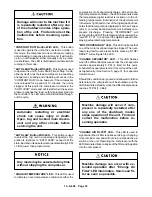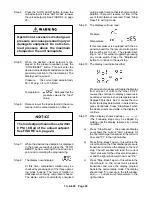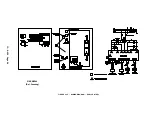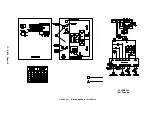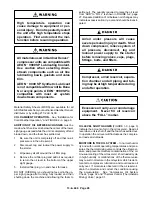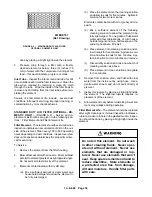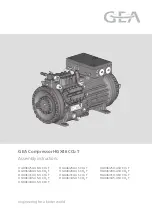
13–8–609 Page 32
Using an oil separator element at ex-
cessive pressure differential can
cause damage to equipment. Replace
the separator when the “Change Sep-
arator” advisory appears.
A sudden drop of zero pressure differ-
ential or sudden heavy oil carryover
may indicate a ruptured element.
Inspection – After removal of separator element,
shine a light inside the element to reveal areas of heavy
dirt or varnish deposits or breaks (ruptures) in element
media.
Removal Of Oil Separator For Inspection Or Re-
placement:
Air/oil under pressure will cause
severe personal injury or death. Shut
down compressor, relieve system of
all pressure, disconnect, tag and
lockout power supply to the starter
before removing valves, caps, plugs,
fittings, bolts, and filters.
Compressor, air/oil reservoir, separa-
tion chamber and all piping and tub-
ing may be at high temperature during
and after operation.
1.
Be certain the unit is off and all system pressure
is relieved.
2.
Disconnect, tag and lockout the power supply to
the starter.
3.
At the bottom of the separator, disconnect the oil
return (scavenge) tube and remove the tube el-
bow.
4.
Remove the spin–on element.
5.
Clean the gasket seating surface of the head.
6.
Inspect and/or replace the separator as neces-
sary. Before reassembly, coat the separator ele-
ment gasket with the same lubricant used in the
unit.
7.
Screw on until gasket makes contact. Hand tight-
en 1/3 to 1/2 turn extra.
8.
Reinstall the tube elbow and oil return line.
9.
Run the unit and check for leaks.
COMPRESSOR OIL SYSTEM CHECK – The follow-
ing readings are based on ambient temperature of 80
_
F (27
_
C) with the system in good condition. The com-
pressor should be at operating temperature at the time
of the checks. One–half hour of loaded operation is
usually sufficient to reach level–out operating tempera-
tures.
Air and Oil Discharge Temperature – 170
_
to 200
_
F (77
_
to 93
_
C)– Read at the gauge on the instrument
panel or check with a thermometer at the discharge
housing.
Compressor Oil Inlet Temperature – 165
_
to 175
_
F
(74
_
to 79
_
C) – Install a tee at the oil filter outlet and
check with a thermometer.
Oil Inlet Pressure – Check at the fitting in the line near
the compressor oil inlet. With air receiver pressure at
100 psi (6.9 Bars), oil inlet pressure should be 65–75
psig (4.5 to 5.2 Bars).
Oil Cooler Oil Pressure Differential (Air–Cooled
Radiator) – Check differential across the oil system by
measuring oil inlet pressure as described above.
Oil Cooler Temperature Differential (Air–Cooled
Radiator) – The oil temperature differential depends
on the temperature of the air at the oil cooler fan and
cleanliness of the core faces. As ambient tempera-
tures and core restrictions increase, the oil cooler outlet
temperature will increase. The oil inlet temperature is
approximately the same as the air discharge tempera-
ture – see the gauge on the instrument panel. The out-
let oil temperature may be checked by installing a tee
at the oil filter outlet.
Содержание ELECTRA-SCREW EBE DH-15 HP
Страница 10: ...13 8 609 Page 2 200EBE797 Ref Drawing FIGURE 1 2 PACKAGE MINIMUM PRESSURE CHECK VALVE SEPARATORS OIL FILTER...
Страница 11: ...13 8 609 Page 3 200EBE797 Ref Drawing FIGURE 1 3 PACKAGE OIL LEVEL GAUGES STARTER CONTROL BOX AIR FILTER...
Страница 14: ...13 8 609 Page 6 DECALS 206EAQ077 212EAQ077 218EAQ077 211EAQ077 207EAQ077...
Страница 15: ...13 8 609 Page 7 DECALS 216EAQ077 217EAQ077 222EAQ077 221EAQ077 208EAQ077...
Страница 32: ...13 8 609 Page 24 FIGURE 4 10 WIRING DIAGRAM DUAL CONTROL 218EBE546 Ref Drawing...
Страница 33: ...13 8 609 Page 25 FIGURE 4 11 WIRING DIAGRAM WYE DELTA 220EBE546 Ref Drawing...
Страница 51: ......

